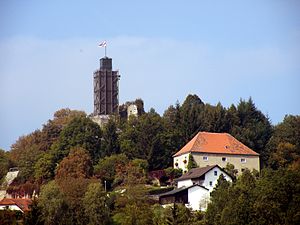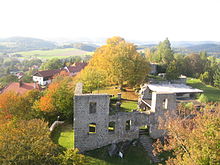Brennberg Castle
| Brennberg Castle | ||
|---|---|---|
| Creation time : | Early 11th century | |
| Castle type : | Höhenburg, summit location | |
| Conservation status: | Restored ruin | |
| Standing position : | Episcopal Regensburg Ministeriale | |
| Place: | Brennberg | |
| Geographical location | 49 ° 4 '19.6 " N , 12 ° 23' 56" E | |
| Height: | 653 m above sea level NN | |
|
|
||
The Burg Brennberg is the ruin of the major castle Ganerbenburg above the Bavarian village of focal Mountain in Upper Palatinate district of Regensburg . It was created by dividing an older complex into two parts in the 14th century ( Oberbrennberg and Unterbrennberg ), which remained connected by a central courtyard.
Geographical location
The castle is located on a granite rock at 653 m above sea level. NHN and about 50 meters above the village of Brennberg and about 23 kilometers east of Regensburg . When the visibility is good, the view extends from the tower to the Alps.
The Falkenstein Castle and the Sengersberg Castle ruins are also nearby in a north-easterly direction, and the Heilsberg Castle ruins in the south . In the north-west are the Siegenstein castle ruins and the Lobenstein castle ruins in the north .
history
The development of Brennberg Castle can be traced back to the de Prenberg family at the beginning of the 11th century. Presumably Wernher I. de Prenberg built the first building on the western castle hill.
The de Prenberg family until 1326
Wernher I. (Wirnto I.) de Prenberg comes from the de Briemberch line with Perinhart de Briemberch as the tribe. Perinhart de Briemberch was a vassal of the St. Emmeram monastery in Regensburg . The focal Berger had then next hochstiftischen fief also own property and subjects. You were later also truchess and ministerial of the Hochstift zu Regensburg. The well-known minstrel Reimar II von Brennberg and the founder of the monastery in Frauenzell , Reimar IV, emerge from them. De Prenberg's coat of arms shows the three "burning mountains" as early as the 11th century.
Wernher I (* 1115; † 1134) was succeeded by his son Wirnto II. And then his son Reimar I. From him, Reimar II descends. His songs are immortalized in the Manessian song manuscript . His successor was his son Reimar III, who was murdered by citizens of Regensburg in 1173. The murder of Reimar III. the de Prenberg family now threatened to die out. So the brother of Reimar III, Bruno, who was canon at the time, had to return to the secular state. Bruno married Berta von Haidau around 1280 and thus became the master of Brennberg. His successor was his son Reimar IV, who also founded the Frauenzell monastery . After the death of Reimar IV, the de Prenberg line ended in the male line . His daughter Agnes married into the family of the mighty Auer. The Auer thus gained control of Brennberg.
The Auer patrician family from Regensburg 1326 to 1483
After the Brennbergers died out in 1326, the fiefdom expired and the rule went back to the Regensburg Monastery. Agnes de Prenberg , the last of the de Prenberg line, married Friedrich I. Auer zu Auburg . This became the master of Brennberg and took over the legacy, the name and the coat of arms of de Prenberg. This is how the Auer de Prenberg and the Auer zu Brennberg called themselves from 1327 . At the same time, Friedrich I was also the commander of Wörth Castle on the Danube and mayor of Regensburg. In 1334, after Friedrich I was expelled from his home town of Regensburg , he expanded Brennberg Castle into his new ancestral home. Supported by his brother Heinrich von Auburg, a tower was added to the western castle hill. On December 28, 1368, the Auer also received the pledge for the Donaustauf Castle from the Roman Emperor Karl .
14th century - division of rule into Oberbrennberg and Unterbrennberg
The two sons Friedrich II. And Hans von Friedrich I Auer zu Brennberg , divided the property in Brennberg in 1379. Friedrich II got the tower and the Münchstein (fountain) in the west, Hans the tower in the east. Since this division, the rule has been divided into Oberbrennberg and Unterbrennberg. In 1466 the last ruler Wilhelm von Auer died on Oberbrennberg. His sister Anna, married to Achatz I von Nussberg near Viechtach, became rulers of Oberbrennberg.
In 1483 the Auer line ended with Christoph II on Unterbrennberg. His sister Anna Beatrix Auer on Unterbrennberg married Albrecht von Murach in 1483 and he became ruler on Unterbrennberg. Albrecht and Anna von Murach on Unterbrennberg had a side altar built in the monastery church in Frauenzell in 1496 in honor of St. Anna. Albrecht von Murach died in 1501 and was buried in Frauenzell. In 1522 Anna von Murach married Joachim Stauff on Unterbrennberg.
The Nussberger family from 1466 to 1568
Achatz I. von Nussberg near Viechtach became ruler of Oberbrennberg because he paid the debts of his late brother-in-law Wilhelm von Au. Achatz I von Nussberger zu Prenberg died in 1480. His grave monument is on the west side of the church tower in the parish church of St. Rupert in Brennberg. His successor was his son Wilhelm II the Nussberger. He died in 1536 and was buried in Frauenzell . His son Haimeran became his successor on Oberbrennberg.
Robbery knighthood
Haimeram der Nussberger, ruler of Oberbrennberg murdered a landlord in his inn when a dispute broke out. Haimeram then fled Bavaria and joined the robber baron Hans Thomas von Absberg . In 1528 Haimeran and other robber barons were arrested in an inn near Heideck. Haimeran died on April 3, 1551 and was buried in Frauenzell. He was followed by his son Wilhelm III von Nussberg, who was a councilor in Straubing.
In 1540 Unterbrennberg passed to Christoph von Rain after brief ownership by Joachim von Stauff . This in turn sold Unterbrennberg to Wilhelm III. from Nussberg. Now Oberbrennberg and Unterbrennberg were in one hand again. The rulers of Nussberger and Joachim von Stauff were rarely at Brennberg Castle. This is how these nurses work for the administration in Brennberg and Frauenzell. In 1568 Wilhelm III died. von Nussberg unmarried. The inheritance of Oberbrennberg and Unterbrennberg was divided by will. One part was given to the Nussberg family on the father's side, the other part to the relatives on the mother's side.
The Lerchenfeld family from 1568 to 1776
Caspar von Lerchenfeld acquired Brennberg Castle in 1568. The rule of Brennberg was divided between his two eldest sons in 1572. Oberbrennberg got Andreas von Lerchenfeld and Unterbrennberg got Georg David von Lerchenfeld. In 1620 Johann Jakob von Lerchenfeld inherited the Unterbrennberg Castle. The ruler Johann Jakob von Lerchenfeld suffered so much from raids and looting during the Thirty Years' War that he had to sell Unterbrennberg Castle to Wilhelm Keck on June 28, 1644. In 1654 Unterbrennberg was bought back by Georg Konrad von Lerchenfeld from Lerchenfeld.
On April 10, 1642, Oberbrennberg Castle burned down for inexplicable reasons. The castle was rebuilt by the Lerchenfeld. In 1686 the whole of Brennberg went up in flames, both castles were destroyed. The lark fields rebuilt both plants. Successor and master of both castles Ober- and Unterbrennberg was Franz Ludwig von Lerchenfeld until his death. His successor was Franz Xaver von Lerchenfeld, who was a councilor in Straubing until his death in 1776.

Thurn und Taxis owned from 1832 to 1935
The daughter of Franz Xaver von Lerchenfeld inherited Oberbrennberg. This made her husband, Joseph von Gumppenberg, ruler of Oberbrennberg. In 1832 the ownership of Oberbrennberg passed with patrimonial jurisdiction to Prince Maximilian Karl von Thurn und Taxis .
Baron Höffels zu Munich later acquired ownership of Unterbrennberg, who in turn sold Unterbrennberg to Baron Closen in 1821 . Until then, a hunter and the camera administrator Georg Rabl lived there. Both were driven out by Baron Closen. Then he had everything sold at Unterbrennberg Castle. The previously present hunter and the camera administrator Rabl looted the castle to compensate themselves. It was then left to decay over the years.
In 1840 Prince Maximilian Karl von Thurn und Taxis also acquired Unterbrennberg. During this time, the remaining buildings on Unterbrennberg were removed and left to decay.
On June 4, 1935, the Principality of Thurn und Taxis donated the castle ruins to the community of Brennberg. In 1980 the remaining structure of the castle was secured and a wooden observation tower was built.
Building description
The castle ruins stand on a 653 meter high granite rock . On its north side the terrain was gently sloping, which is why a moat was built there for protection. The oldest part of the castle, the Romanesque keep and the house, date from the 11th century. Friedrich von Au expanded the castle significantly, in the 14th century the so-called Auerturm and a deep draw well were built in the western part . After the severe fire at the beginning of the 18th century, a three-story castle was built on the foundations of the Gothic house . After the fire of 1686, a granary with a hipped roof was built in the east of the complex . This building still stands today and serves as a residential building.
Others
Due to excavations and restoration work in the 1980s, the entire castle complex is now freely accessible and, thanks to the tower that was built, serves as a lookout point. The observation tower is accessible all year round.
With the 50 km long Brennberger Burgensteig, the castle is part of the Regensburger Burgensteige .
For the creation of topographic maps was u. a. a survey point installed at Brennberg Castle .
The castle ruins can be rented for celebrations such as weddings and birthdays. Every two years a castle festival is held on the castle grounds; In addition, concerts, open-air cinema events and anniversaries of the clubs take place at Brennberg Castle.
literature
- Günter Moser, Bernhard Setzwein , Mathias Conrad: Upper Palatinate Castles - A journey to the witnesses of the past . Buch und Kunstverlag Oberpfalz, Amberg 2004, ISBN 3-935719-25-6 , pp. 82–85.
- Andreas Boos : Castles in the south of the Upper Palatinate . Universitätsverlag Regensburg, Regensburg 1998, ISBN 3-930480-03-4 , pp. 117–123.
- Ursula Pfistermeister : Castles of the Upper Palatinate . Verlag Friedrich Pustet, Regensburg 1974, ISBN 3-7917-0394-3 , p. 84.
- Emil Fuchs: The rule of Brennberg , Regensburg 1979
Individual evidence
- ^ Emil Fuchs: Die Herrschaft Brennberg , Regensburg 1979, p. 14.
- ^ Emil Fuchs: Die Herrschaft Brennberg , Regensburg 1979, p. 14.
- ^ Emil Fuchs: Die Herrschaft Brennberg , Regensburg 1979, pp. 14-15.
- ^ Emil Fuchs: Die Herrschaft Brennberg , Regensburg 1979, pp. 38–42.
- ↑ Emil Fuchs: Die Herrschaft Brennberg , Regensburg 1979, pp. 42–46.
- ↑ Emil Fuchs: Die Herrschaft Brennberg , Regensburg 1979, pp. 46-48.
- ^ Emil Fuchs: Die Herrschaft Brennberg , Regensburg 1979, p. 50; 57-61.
- ↑ Emil Fuchs: Die Herrschaft Brennberg , Regensburg 1979, pp. 62–63.






